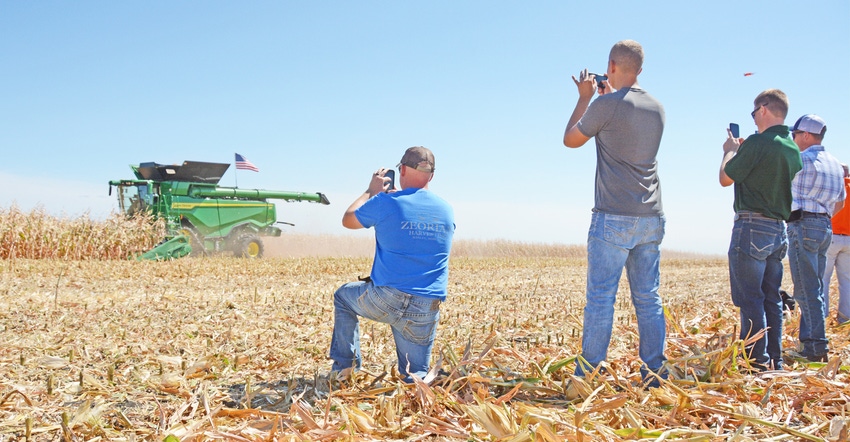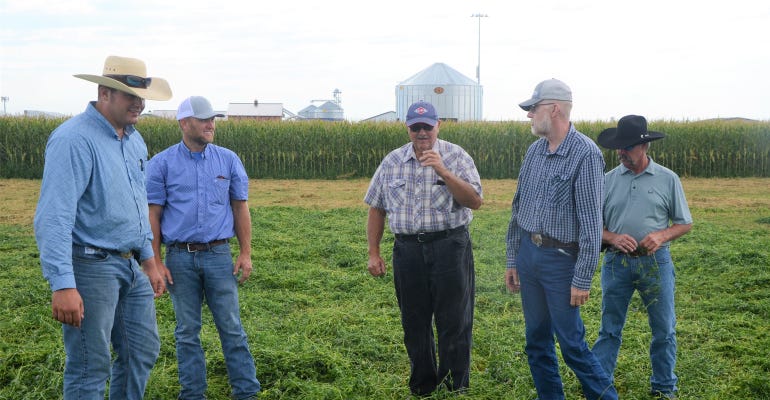
What do you do when you’ve got 400 acres of corn to harvest, hay to bale and chutes to try out? You put together a virtual farm show — and you bring in farmers to evaluate it all.
When Farm Progress organizers realized they’d have to cancel the Farm Progress Show and Husker Harvest Days because of the COVID-19 pandemic, they plowed every bit of their vast farm show experience into creating the first Farm Progress Virtual Experience, complete with an online trade show, breakout learning sessions, and of course, the hallmark of every Farm Progress Show and Husker Harvest Days: the field demonstrations.
“But if we’re going to have field demonstrations, we needed to have farmers,” says Matt Jungmann, national events director for Farm Progress. Enter the FPVX farmer panelists.
Editors from six states set about recruiting farmers to come to field demonstrations at the Farm Progress Show site near Boone, Iowa, and the Husker Harvest Days site near Grand Island, Neb., where they watched more than 100 pieces of equipment run through real-world conditions.
They recorded their observations and shared their thoughts on-camera for a special wrap-up segment with Willie Vogt, executive director of content and user engagement for Farm Progress.
In an Iowa cornfield
Here’s a look at the farmer team that gathered in Boone to observe combines, headers, tractors, grain carts and tillage equipment:
Allyn Buhrow. Hailing from near Ashton, Ill., in Lee County, Buhrow raises corn and soybeans with his father, Prairie Farmer Master Farmer Craig Buhrow, and mother, Marjorie Buhrow. Buhrow is an ag economics graduate of the University of Illinois and is a longtime seed dealer for Pioneer, operating a successful dealership from his home base in north-central Illinois. He and his wife, Amy, have two children who show livestock in 4-H and FFA.
Quentin Connealy. A fifth-generation farmer from Tekamah, Neb., Connealy operates Connealy Farms with his dad and uncle along the Missouri River bottoms. They raise primarily corn and soybeans under irrigation, but Connealy also may be recognized as the “wakeboarding farmer” from a viral video in May 2017 when he and his uncle tried to make the best from a tough flooding situation.

GROUP EFFORT: Farmers from the Midwest converged on the Farm Progress Show site near Boone, Iowa, to assess ag equipment. The group included (from left) Quentin Connealy, Nebraska; Cale Juergensen, Iowa; Scott Henry, Iowa; Seth Gerlach, Iowa; Brian Scott, Indiana; and Allyn Buhrow, Illinois.

Seth Gerlach. Gerlach is a central Iowa farmer north of Nevada. He is a partner in Gerlach Farms, a family operation that hosted the Farm Progress Show in 1980. The farm was established in 1960, and today it employs several family members and is primarily a grain farming operation. Seth’s dad, Kevin, is business manager and Seth’s great uncle, Dwayne Gerlach, is president. Dwayne and his late brother, Willard Gerlach, co-hosted the 1980 FPS with two other neighboring families. Seth graduated from Iowa State University with a bachelor’s degree in agronomy in 2016.
Scott Henry. Henry is a fourth-generation family farmer from Nevada in central Iowa, 30 minutes east of the FPS site at Boone. Scott and his brother farm with their dad, Steve, raising seed corn, commercial corn and soybeans. In addition to the row crop operation, the family owns contract finishing facilities for hogs and a cattle feedyard focused on backgrounding and custom feeding cattle. Their farming operation is LongView Farms. Scott graduated from Iowa State with a degree in ag business in 2012. Scott is business development manager for LongView Farms.
Cale Juergensen. Juergensen farms with his family near Churdan, 40 miles northwest of Boone, Iowa. Brothers Cale and Conner raise corn, soybeans and 25,000 head of wean-to-finish pigs per year. They own a small herd of beef cows. Cale earned his associate degree in ag production from Iowa Lakes Community College in 2013. The Juergensens were named Iowa Master Pork Producers by the Iowa Pork Producers Association a few years ago. Their father, Chris, died in August 2012, and their mother, Jill, took over the family operation while her five children took on larger roles on the farm. Cale and Connor built a new hog building and began raising their own hogs in December 2012, while still in college.
Brian Scott. Scott raises corn, soybeans, popcorn and wheat on his family’s farm near Delphi in northwestern Indiana, working with his dad to operate Scott Farms. A graduate of Purdue University, Scott enjoys precision agriculture and learning about new equipment, and he and his wife, Nicole, are raising two young sons on the farm. His family has raised popcorn on contract with Weaver for several generations. Scott is a popular social media presence under the moniker “The Farmer’s Life,” where he shares information about their operation and use of technology for consumers.
On-site in Nebraska
Five producers came to the Husker Harvest Days site near Grand Island, Neb., in mid-August to see hay equipment and cattle chutes in action:
Jeremy Row. Although fifth-generation farmer and rancher Jeremy Row has been farming full time since 2015, he grew up around agriculture on his family's farm near Shickley, Neb., where he now operates a cow-calf, feedlot, stocker-feeder, hay and row crop operation. In addition to alfalfa hay, he also raises corn, soybeans, wheat, sorghum and food-grade white corn. "We're going to upgrade our swather sometime in the near-to-distant future. In a humid environment, we need a good machine with a good conditioner that's going to get a good crimp, so we get decent drydown, but at the same time, not lose all of our leaves," Row says. "We also do a lot of small grain hay — rye, triticale, oats and some forage sorghum. So I need a machine that's versatile enough that I can lay down some rye, then grass, and the next day do alfalfa."
Darian Fuelberth. After graduating from Northeast Community College, Fuelberth worked in several feedlots before returning to his family's cow-calf operation near Stuart, Neb. Fuelberth practices rotational grazing, and in addition to pasture hay, also uses alfalfa and annual forage crops for hay. "I rent three pivots. One is alfalfa, and the others I usually put in a forage crop every year," he says. "This year, we did two pivots with German foxtail millet."

TALK IT OVER: Five Nebraska producers came to the Husker Harvest Days site to see the latest hay equipment and cattle chutes in action as part of the filming of the Farm Progress Virtual Experience. They include (from left) Jeremy Row, Mike Manion, Ron Nelssen, Don Batie and Darian Fuelberth.

Ron Nelssen. Nelssen has been in the hay business near Inavale in south-central Nebraska for nearly 60 years, and started putting up hay for his dad when he was 13 years old. The bread and butter of his operation is the haying equipment, which he likes to keep up-to-date. "We put around 10,000 up to 20,000 bales through them before we trade. I like to see 10,000 bales a year on a baler," he says. In addition to two balers and a mower-conditioner, Nelssen is a believer in gyro rotary rakes and leaving distance between windrows. "I like to see my windrows as wide as the conditioner, and they're 8.5 feet wide," Nelssen says. "Two things dry out hay: humidity and air, or wind movement. It can't have enough moisture internally to cause damage to the package when it's been put up."
Mike Manion. Manion was backgrounding calves and raising cow-calf pairs since before he graduated high school in 2002. Now, he runs a cow-calf herd, a backgrounding feedlot, and a hay operation with his family near Hemingford in the Nebraska Panhandle. Manion's part of the world is a semiarid climate. "One of the main things I'm looking into is a steamer to simulate dew or add moisture to a windrow,” he says. “We can usually get the hay dry, but then it gets so dry we're losing a lot of leaves. We fight to make good quality hay that keeps the leaves in it."
Don Batie. For 20 years, Batie operated Batie Cattle Co., a feedlot in Lexington, Neb., where he raised alfalfa as well. But he exited the cattle business in 2004 and the forage business this year. Now, Batie focuses solely on irrigated corn and soybeans. In recent years, he's become more involved in the Nebraska On-Farm Research Network, working with the University of Nebraska-Lincoln to conduct trials testing different inputs and practices. This includes trials comparing soybean populations, evaluating active hydraulic downforce on planter row units, and studying high-speed planting using a planter not designed for high speed. Another study he's starting this fall involves comparing two cover crops, cereal rye and winter wheat.
About the Author(s)
You May Also Like








